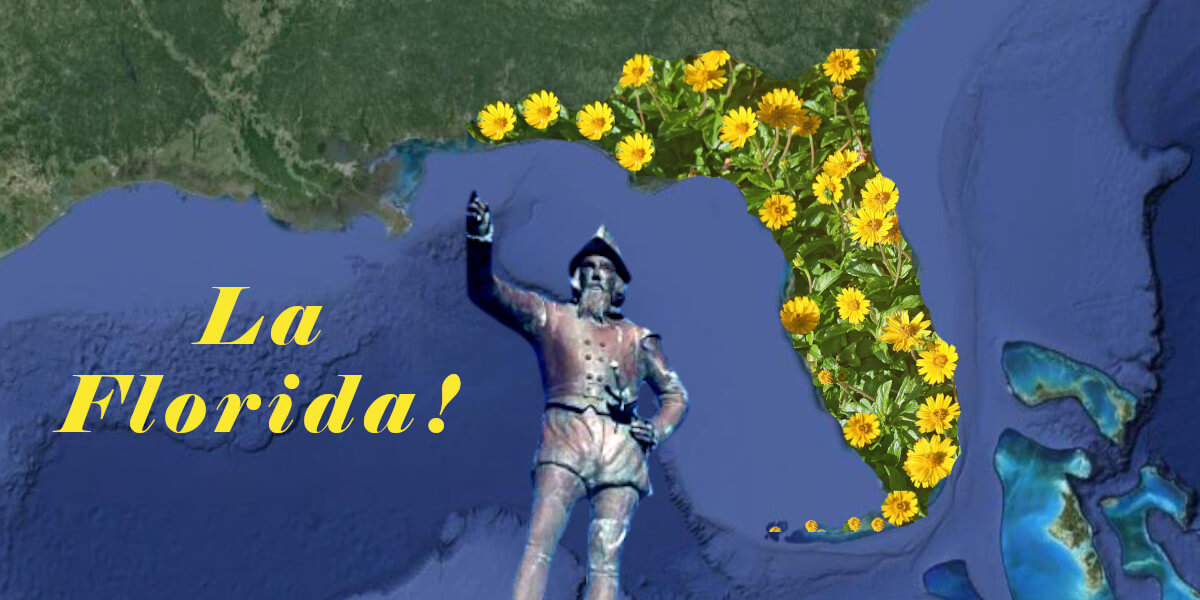Image: “Wedelia Invades Florida” by Amy Howard
Pre-Columbian Florida was so lovely that Ponce de Leon named it La Florida, the Land of Flowers. Maybe that planted the seed of gluttony. Now, we represent our state with flowered shirts, flowered sandals, flowers in our hair, in our drink, on our salads, and scattered on the ground by a Seminole woman on the official Florida State Seal.
Still, it’s not enough. We bring plants home from other states and countries with full confidence that they will just love the Florida sunshine. Certainly, the Florida ecosystem has happily accepted thousands of plants from other places. When they come from elsewhere, we call them Exotic. When they play fair, we ordain them as Florida Friendly.
We also bring thousands of people to the state. In 2022, Florida gained about 250,000, netting the highest net migration of all the states, and St. Johns County grew the most of all the counties in Florida, taking on over 13,000 people in one year! The more people move to Florida, the more ecosystem we erase to build neighborhoods, and the more we need plants that don’t need the ecosystem. In short, we bring in invasive plants.
My friend, Jim, says humans are the most invasive species on the planet; how arrogant can we be to call other species invasive? Well, he has a point on a meta-narrative level. But down here in the dirt, when exotic plants push out the natives, our lovely old Florida just starts disappearing. If you live in Florida because you love Florida, you might want to help it stay Florida.
Definition of Invasive
Was it here when Ponce de Leon arrived? It’s a native.
(Says the Florida Native Plant Society).
Did it arrive later? It’s ‘exotic’.
Does it force out the natives? Guess what? It’s INVASIVE.
Does it disrupt the native ecosystem? Guess what? It’s INVASIVE.
Can it radically change the nature of Florida? Guess what? It’s INVASIVE.
A solution to the problem
My native landscape friend, Ely, actually volunteers long, hard hours pulling invasive plants out of the GTM Reserve. Considering world travel and species spread will only increase, I asked Ely what is her end game with the invasives battle. She said, “It buys time for the ecosystem to adapt to the invasives.”
What can we all do? We can learn the invasives around us. If you walk in your neighborhood or in the park, you are sure to see an invasive plant that is eroding Old Florida. Get to know them, and work on getting rid of them. Give the ground back to the natives.
Examples of plants that are invasive to Northeast Florida
Colonization and world travel have introduced countless exotic plants to Florida and St. Johns County. Many of these plants have destroyed treasured features of our landscape. The Florida Natural Areas Inventory publishes a helpful list with details on each plant. Closer to home, the GTM Reserve produced a brochure specific to Northeast Florida. Here are the plants from that brochure:
Air Potato (Dioscorea bulbifera)
Asparagus Fern (Asparagus aethiopicus)
Brazilian Pepper (Schinus terebinthifolius)
Chinese Tallow (Sapium sebiferum)
Golden Rain Tree (Koelreuteria elegans)
Guava (Psidium guajava)
Heavenly Bamboo (Nandina domestica)
Japanese Climbing Fern (Lygodium japonicum)
Japanese Honeysuckle (Lonicera japonica)
Lantana (Lantana camara)
Mexican Petunia (Ruellia simplex)
Mimosa (Albizia julibrissin)
Silverthorn (Elaeagnus pungens)
Sword (Boston) Fern (Nephrolepis cordifolia)
Wax Begonia (Begonia cucullata)
Wedelia (Sphagneticola trilobata)
The common names for these plants vary among different cultures. That is why it’s important to use the scientific name when researching them. Also, some invasive plants have native relatives, some of which look very much alike. It’s important to know who exactly you are dealing with before you go evicting plants.


